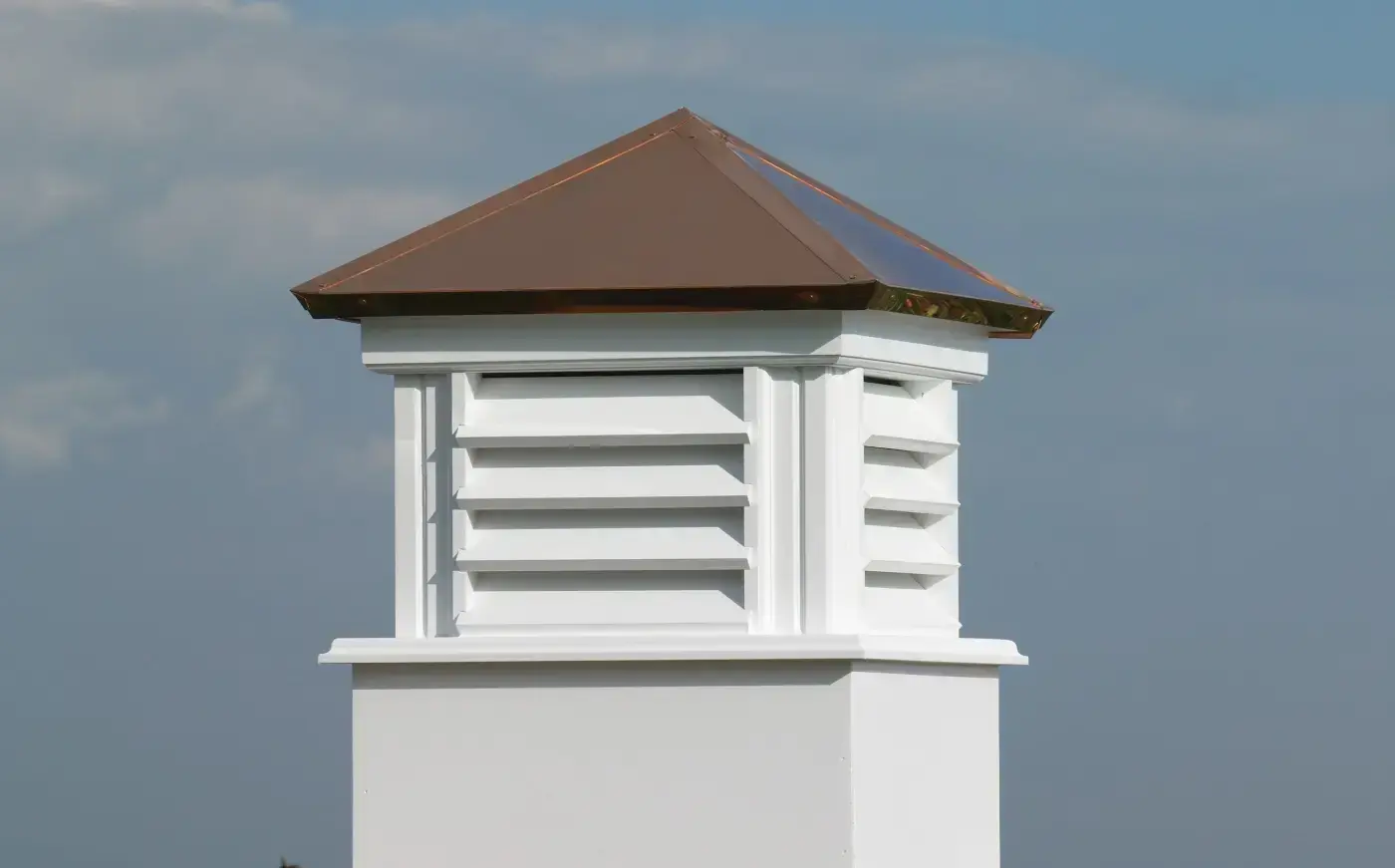Adding a cupola is a delightful and easy way to upgrade your home’s aesthetic and functional appeal. Cupolas add visual interest and can serve various practical purposes, depending on the type, style, and location. Whether you want to add light to your home, need ventilation for a workshop or barn, desire visual interest on a roofline, or all three, let’s look at how cupolas add elegance, charm, and efficiency to your home.
What is a Cupola?
While there are different types of cupolas, they generally share a few traits, like being smaller than the building they’re placed on, having pointed roofs, and usually being angled in shape, either square or hexagonal. Cupolas are structures placed on the roofs of buildings, often for ventilation, lighting, or aesthetic purposes.
Picture a classic American barn; can you see the tiny pointed structure on top? It looks like a small, enclosed pergola or an upside-down cup. Cupolas, often adorned with weathervanes, are a quintessential feature of American architecture, though humans have used them for thousands of years.
These structures are typically louvered to allow fresh air and light into the building. The slanted woodwork is similar to wooden slatted shutters or layered wooden siding on the outside walls of a home. The layered wooden slats let in air and light while repelling the elements, such as rain, wind, hail, etc. In modern times, cupolas are often chosen as a design element to add a distinctive feature to a single-story building. However, they still serve a practical purpose for many homeowners.
Cupolas: A Brief History
Cupolas have an ancient history and have been used by humans for thousands of years worldwide. While modern technology now generally performs the functions of ventilation and off-gassing, before the era of the compressor, airflow and quality were handled by architectural design, including cupolas. Cupolas are external structures placed on roofs that act as vents, allowing old air to escape while bringing fresh air inside. This performs two critical functions: stale air and unwanted gasses (from animals, machinery, ovens, etc) have a way out of the building. Second, fresh, outdoor air, full of oxygen, is allowed into the structure. This creates a safer indoor environment and improves the quality of life.
Cupolas, in various forms, have been in use for centuries. Historians show the use of cupolas in Indian, Middle Eastern, and Islamic architectural designs thousands of years ago. These ancient cupolas often looked quite different than the square topper on a more modern farmhouse; they were usually large, domed, decorated, and built into the building rather than perched or added on top.
In fact, in 13th-century Venice, the intricately decorated cupolas in Basilica San Marco, a famous and ancient cathedral in Italy, are thought to have played a role in the city's political and social transformation into a cultural powerhouse. At the time, most of Venice’s citizens were illiterate, and religious imagery, often politically inspired, helped shape and influence the citizens of Venice's viewpoints.
Design and Style Elements of Cupolas
Cupolas vary significantly in style and design, meaning there is a type of cupola to fit your home or property’s unique needs. From large belvedere-style cupolas that double as a personal observatory for viewing the stars or countryside to a tiny structure perched on a chicken coop, cupolas can bring style, form, or function to almost any structure.
Most modern cupolas are square or hexagonal shaped, with a pointed roof. They are typically separate structures built into or added to the roof of a building and are made up of:
Base: The area that attaches the cupola to the roof and seals it.
Body: This is the main bulk of a cupola and will boast louvered slats for ventilation or glass windows for light
Cap: The cupola's roof is the cap, often pointed to help keep the elements at bay. Copper is a popular material for roofs since it adds visual interest, is highly durable, and reflects sunlight, supporting cooler temperatures.
Cupolas are more commonly used in modern architecture as design elements and to bring light into a building rather than to ventilate a barn. However, ventilation is still needed in structures like garages, sheds, barns, and chicken coops, making cupolas as practical or aesthetic as you wish.
Cupolas designed for light typically forgo the louvered sides and instead are made up of glass windows. Natural light is both essential and luxurious, and for some buildings, a cupola can open up a room to the sun in ways that windows cannot.
Explore Cupolas with Walpole Outdoors!
Take a look at Walpole’s fine cupola offerings. Each cupola comes in different sizes, and our experienced team works with you to ensure a custom fit, seamless shipping, and proper installation.
Brittany Cupola: Walpole’s Brittany Cupola boasts generously spaced louvers on its four sides. This square cupola is magnificent and perfectly matched for any estate home with its sloping copper roof. The Brittany Cupola is crafted from cellular vinyl.
Wynnfield Cupola: The Wynnfield Cupola is the perfect fit for any home or structure on your property. It features a pointed, sloped copper roof and elegantly louvered sides. The cupola is proudly made from cellular vinyl.
Ipswich Cupola: This magnificent cupola is beautiful in any home. The Ipswich cupola features a sloped copper roof and hinged windows for easy access. It can also be added to the two larger Ipswich Cupola sizes only (46"H and 61" H). It is crafted from cellular vinyl for superior weather resistance.
Are you wondering if a cupola is the right fit for you and your property? Talk to one of Walpole’s design consultants to determine if a cupola matches your home and what size and style best suits your needs.
